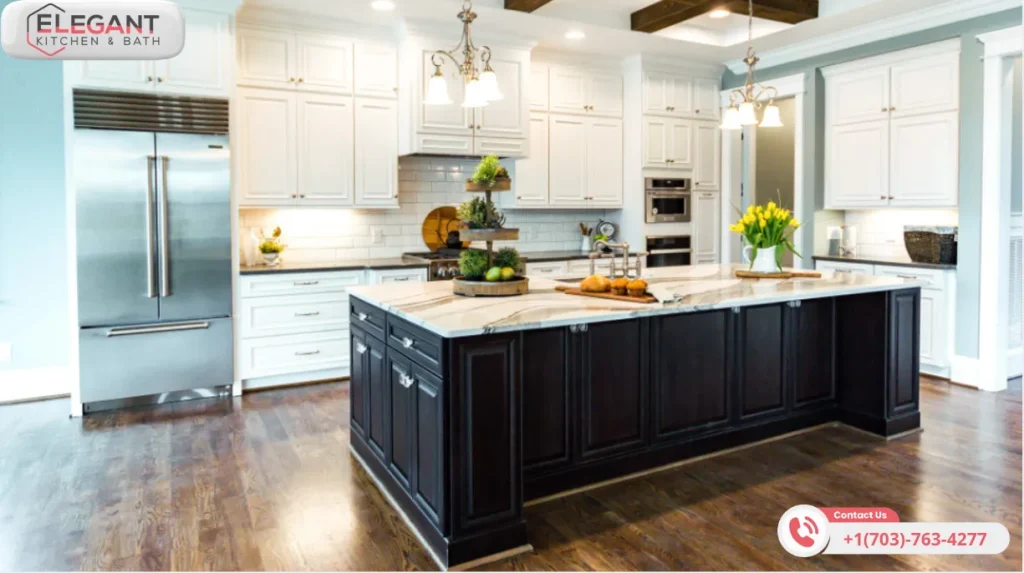Transforming your kitchen often begins with a simple upgrade: lighting. Elegant lighting designs not only enhance the overall aesthetic but also improve functionality in this essential space. This article will cover how to assess your kitchen’s lighting needs, explore luxury kitchen lighting ideas, and provide tips for choosing the perfect fixtures. By addressing common challenges like insufficient brightness or outdated styles, readers will learn how to elevate their kitchen remodel with beautiful and effective lighting solutions. Whether it’s selecting the right ceiling fan or maximizing lumens for your kitchen cabinets, this guide will empower you to create an inviting atmosphere.
Key Takeaways
- Lighting design enhances kitchen aesthetics and functionality through careful selection and placement of fixtures
- Balancing natural and artificial light creates a welcoming atmosphere that complements cabinetry
- Energy-efficient bulbs reduce costs while maintaining brightness and supporting a sustainable kitchen
- Regular maintenance ensures longevity and elegance of luxury lighting in the kitchen space
- Strategic lighting can highlight key areas, improving visibility and enhancing the overall design
Transform Your Kitchen With Elegant Lighting Designs
Lighting plays a crucial role in enhancing kitchen aesthetics, making it essential to understand its impact when designing the space. By balancing functionality and style in lighting choices, homeowners can complement their cabinetry while choosing fixtures, such as bronze lampshades or sleek steel elements, that align with their interior design vision. Additionally, creating ambiance with light and shadow will add depth and warmth to the overall kitchen environment.
Understanding the Impact of Lighting on Kitchen Aesthetics
Effective kitchen lighting is essential for creating an inviting atmosphere while enhancing functionality. Track lighting is an excellent choice for illuminating critical areas, allowing homeowners to direct light exactly where it is needed most. For example, using task lighting in food preparation areas ensures that surfaces are brightly lit, making meal prep more efficient and enjoyable.
Natural daylight can greatly influence the feel of a kitchen, and incorporating elements such as crystal fixtures can add elegance and sophistication. By blending stylish lighting options with strategic placement, homeowners can achieve a warm ambiance that highlights their cabinetry and overall design. Selecting the right sources of light creates a cohesive look while addressing practical needs, transforming the kitchen into a beautiful and functional space.
Balancing Functionality and Style in Lighting Choices
When considering kitchen lighting choices, balancing functionality and style is vital for a successful renovation. Homeowners should pay attention to color temperature, as this influences the overall ambiance of the space. Warm white bulbs create a cozy atmosphere that complements wood cabinetry, while cooler temperatures can enhance modern designs and sleek features.
Pendant lights are an excellent option for bringing both style and practicality to kitchen spaces. They can be strategically placed over islands or dining areas, providing focused illumination where it’s needed most. By selecting pendant lights that use energy-efficient bulbs and match the kitchen’s design theme, homeowners can create a cohesive look that marries aesthetic appeal with essential functionality.
Creating Ambiance With Light and Shadow
Creating a welcoming atmosphere in the kitchen involves the strategic use of light and shadow. Accent lighting can play a vital role in highlighting specific areas, such as the sink or countertops, while softening harsher overhead light from ceiling fixtures. This approach allows homeowners to appreciate the beauty of their cabinetry and other design elements, contributing to an inviting farmhouse aesthetic.
Incorporating stylish light fixtures enhances the overall environment, offering both illumination and visual appeal. By carefully placing task lighting around key work areas, such as the kitchen island, individuals can achieve the ideal balance of form and function. This thoughtful lighting design transforms the kitchen into a space that is not only functional but also an enjoyable gathering area for family and friends.
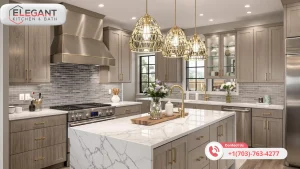
Assessing Your Kitchen’s Lighting Needs
Identifying key areas for illumination is essential for transforming a kitchen with elegant lighting designs. Homeowners should consider the balance of natural light versus artificial light, as well as analyze current lighting limitations. This assessment will provide insight into how to enhance the space’s architecture, optimize brightness with fixtures like a chandelier or lantern, and align with the color scheme of the cabinetry.
Identifying Key Areas for Illumination
Identifying key areas for illumination in a luxury kitchen is crucial for achieving both functionality and elegance. Homeowners should focus on locations such as the cooking zone, dining area, and prep spaces, ensuring effective lighting enhances these essential parts of the room. Incorporating recessed lights paired with dimmers provides versatility to adjust brightness according to the task at hand or to create a softer ambiance for entertaining guests.
Highlighting features such as copper fixtures can elevate the visual appeal and contribute to a stunning design. Strategically illuminating countertops with under-cabinet lights not only improves visibility for meal preparation but also showcases the cabinetry‘s beauty. By analyzing these areas, homeowners can establish a well-lit kitchen environment that meets their needs while enhancing the overall decor.
Considering Natural Light Versus Artificial Light
Balancing natural light and artificial light is critical in kitchen design. Positioning windows strategically allows sunlight to illuminate the countertop, reducing the need for excessive artificial lighting during the day. This natural illumination works harmoniously with selected metal fixtures, such as silver sconces, providing an elegant touch while maximizing brightness and enhancing the overall aesthetics.
Artificial lighting is essential for evening use and in areas where natural light falls short. For instance, installing stylish sconces alongside countertops can draw attention to both the workspace and the cabinetry, creating an inviting atmosphere. Homeowners should consider integrating adjustable lighting options that complement the existing natural light, ensuring each lighting source contributes to a well-lit, functional, and visually appealing kitchen.
Analyzing Current Lighting Limitations
Analyzing current lighting limitations involves evaluating how effectively the existing fixtures illuminate essential areas, such as the kitchen wall and floor. Homeowners should consider whether the current lighting meets their needs, particularly in the dining room and cooking zones. If the light is too dim or focused inappropriately, it can affect usability and ambiance, necessitating an update to include brighter or strategically placed fixtures that enhance both function and design.
Additionally, evaluating the color temperature measured in kelvin is vital when assessing lighting efficiency. A mismatch between the warmth of the cabinetry and the cooler tones of the existing lights can create an inconsistent appearance. Homeowners may find that incorporating adjustable pendant lights over key areas, like kitchen islands or dining spaces, not only improves brightness but also harmonizes the overall aesthetic, making the kitchen an inviting place for family and guests.
Luxury Kitchen Lighting Ideas to Elevate Your Space
Installing statement chandeliers can create a stunning focal point in an elegant kitchen, while incorporating pendant lights above workspaces adds both style and practicality. Utilizing under-cabinet lighting introduces subtle elegance, enhancing the atmosphere without overwhelming the design. Adding recessed lighting contributes a modern touch, and experimenting with backlighting adds depth and visual interest to various elements. Each of these ideas offers unique benefits for homeowners looking to remodel their kitchens effectively.
Installing Statement Chandeliers for a Focal Point
Installing statement chandeliers in the kitchen can significantly enhance its visual impact, serving as an eye-catching focal point that draws attention to design features and cabinetry. Homeowners can choose from various styles, such as modern, vintage, or industrial, to match their overall aesthetic. A well-placed chandelier not only illuminates the space but also sets a sophisticated tone, transforming the kitchen into a gathering area that invites family and friends to come together.
When selecting a statement chandelier, consideration should be given to its size and placement to ensure it complements the existing layout and design elements of the kitchen. For instance, a large, ornate chandelier can add dramatic flair over an island or dining table, effectively blending functionality and style. By integrating a statement piece like this, homeowners can elevate their kitchen’s ambiance while enhancing the overall aesthetic appeal, making it a more inviting space for everyday use and special occasions.
Incorporating Pendant Lights Above Workspaces
Incorporating pendant lights above workspaces in the kitchen serves both aesthetic and functional purposes, making it a valuable consideration for homeowners. These fixtures provide direct illumination for tasks, enhancing visibility and safety while preparing meals or completing other kitchen activities. By selecting pendant lights that align with the overall design theme, such as contemporary or rustic styles, homeowners can create a cohesive look that elevates the space.
Moreover, the placement of pendant lights can dramatically transform the kitchen’s ambiance. Installing them above counters or islands not only improves task lighting but also adds a touch of elegance to the kitchen decor. Opting for energy-efficient bulbs within these pendants can further enhance sustainability while ensuring a bright and inviting environment for everyday use and gatherings.
Utilizing Under-Cabinet Lighting for Subtle Elegance
Utilizing under-cabinet lighting can significantly enhance the elegance of a kitchen by providing practical illumination while showcasing cabinetry and countertops. These lighting solutions not only brighten workspaces but also create a visually appealing atmosphere, making it easier for homeowners to prepare meals and serve guests. With options such as LED strips or puck lights, homeowners can select energy-efficient fixtures that align with their aesthetic choices, ensuring a blend of functionality and style.
Incorporating under-cabinet lighting can also address common kitchen pain points, such as insufficient task lighting in food preparation areas. Strategically placing these lights can reduce shadows and improve visibility, allowing for safer meal prepping. Furthermore, the soft glow from under-cabinet fixtures can enhance architectural details and the richness of the cabinetry, contributing to a sophisticated overall design that elevates the kitchen’s ambiance.
Adding Recessed Lighting for a Modern Touch
Adding recessed lighting in a kitchen offers a modern touch that enhances both aesthetic appeal and functionality. This type of lighting can be seamlessly integrated into the ceiling to provide even illumination without hanging fixtures obstructing the space. Homeowners often find that installing recessed lights over key areas such as islands and countertops significantly improves visibility, making everyday tasks more efficient.
Recessed lighting also provides versatility, as it can be paired with dimmer switches to adjust brightness based on the time of day or occasion. This adaptability makes it ideal for creating a welcoming atmosphere during family gatherings or intimate dinners. When planning the layout, homeowners should consider strategically placing recessed lights to emphasize design elements and cabinetry:
- Install recessed lights above workspaces for enhanced visibility.
- Use dimmers to adjust lighting according to mood and need.
- Focus on design features such as cabinetry and architectural details.
Experimenting With Backlighting for Depth
Experimenting with backlighting in a kitchen can create stunning visual depth and highlight design features like cabinetry and countertops. This lighting technique involves placing light sources behind or beneath certain elements, enhancing their appearance and creating a warm, inviting atmosphere. Homeowners can consider features such as under-cabinet LED strips or illuminated shelves to achieve a contemporary look while improving functionality.
By utilizing backlighting, homeowners can effectively address common lighting challenges in the kitchen. For example, showcasing a beautiful backsplash with a soft glow not only enhances its aesthetic appeal but also ensures the area is well-lit for food preparation. This practical approach to kitchen design allows for both beauty and functionality, making the space inviting for everyday use and entertaining guests:
- Illuminate cabinetry from within for a striking effect.
- Use under-cabinet lighting to enhance preparation areas.
- Integrate LED strips behind design elements for depth.
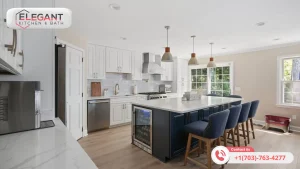
Choosing the Perfect Lighting Fixtures
Selecting the perfect lighting fixtures is fundamental in transforming a kitchen’s ambiance. Homeowners should consider materials that harmonize with their cabinetry and overall design. Matching fixture styles with the existing interior aesthetics ensures cohesiveness. Additionally, considering energy efficiency when choosing luxury lighting can contribute to sustainability without sacrificing elegance. These factors collectively enhance both the visual appeal and functionality of the kitchen space.
Selecting Materials That Complement Your Kitchen
Selecting the right materials for lighting fixtures can significantly enhance the overall aesthetic of a kitchen. Homeowners should consider materials that complement their cabinetry, such as brushed nickel, bronze, or glass. Using fixtures crafted from these materials not only elevates the design but also ensures durability, offering a long-lasting investment that aligns with the kitchen’s style.
Additionally, mixing materials thoughtfully adds visual interest without overwhelming the space. For instance, pairing wooden fixtures with sleek metal accents can create a harmonious blend that resonates with modern designs while maintaining warmth. This approach allows homeowners to achieve a cohesive look that enhances both functionality and elegance, making the kitchen an inviting focal point of the home.
Matching Fixture Styles With Interior Design
When matching fixture styles with interior design, homeowners should prioritize a cohesive aesthetic that reflects their overall kitchen theme. For example, rustic kitchens benefit from farmhouse-style fixtures, such as wrought iron chandeliers or vintage pendant lights, while contemporary designs may call for sleek, minimalistic options in materials like brushed nickel or glass. Carefully selecting light fixtures that align with cabinetry finishes and colors can enhance the space’s visual harmony, ensuring every element complements the kitchen’s design.
Additionally, taking the time to consider the scale and proportion of lighting fixtures is essential for achieving a balanced look. Oversized chandeliers can create a dramatic focal point in spacious kitchens, while smaller fixtures are better suited for intimate areas. By integrating appropriate styles and sizes, homeowners can maximize both functionality and visual appeal, leading to a well-lit kitchen that invites both functionality and style:
Considering Energy Efficiency in Luxury Lighting
Considering energy efficiency in luxury lighting is essential for homeowners seeking both elegance and sustainability. By opting for LED bulbs in decorative fixtures, homeowners can significantly reduce energy consumption without compromising on style. For example, a beautifully designed chandelier using energy-efficient lighting can illuminate a kitchen while minimizing electric costs, allowing for an attractive solution that supports eco-friendly living.
Incorporating smart lighting systems also enhances energy efficiency, enabling homeowners to control their kitchen lighting based on usage and preference. These systems allow for automated dimming or scheduling, ensuring that lights are only on when needed. Such practical applications not only contribute to reducing energy waste but also align with the stylish ambiance desired in luxury kitchen designs.
Installing Your Elegant Lighting Design
Preparing the kitchen for elegant lighting design involves careful planning and organization. Homeowners must assess whether to choose professional installation or opt for a DIY approach, depending on their expertise and comfort levels. Additionally, following essential safety tips during the installation process is crucial to ensure both efficiency and security. This section will explore these topics in detail to guide homeowners in their renovation journey.
Preparing Your Kitchen for New Installations
Preparing the kitchen for new lighting installations requires careful consideration of both existing infrastructure and desired design outcomes. Homeowners should first assess the current electrical setup to ensure it can support any new fixtures, such as chandeliers or recessed lights. This step not only prevents electrical issues but also helps in selecting fixtures that align with the kitchen’s overall functionality.
Additionally, proper planning involves visualizing how new lighting will enhance the kitchen’s aesthetic. Homeowners can sketch a layout or use design tools to map out where each fixture will go, considering factors like the kitchen’s layout and existing cabinetry. This thoughtful approach helps ensure that the new lighting complements the cabinetry while providing adequate illumination where it’s needed most, effectively transforming the kitchen into a beautiful and welcoming space.
Deciding Between Professional Installation and DIY
When homeowners consider transforming their kitchen with elegant lighting designs, they face the important decision of whether to opt for professional installation or take a DIY approach. Professional installation offers the benefit of expertise, ensuring that lighting fixtures are installed correctly and safely. This approach can be particularly valuable for complex designs, such as chandeliers or recessed lighting, where safety and technical knowledge are essential for optimal functionality.
On the other hand, a DIY installation can provide homeowners with a sense of accomplishment and the potential for cost savings. By following detailed guides and utilizing available resources, individuals can install simpler fixtures themselves, such as pendant lights or under-cabinet lighting, tailored to their style preferences. Before making a decision, homeowners should evaluate their comfort level with electrical work and the specific requirements of their lighting designs:
- Assess the complexity of the lighting design.
- Evaluate DIY skills and available time.
- Consider the budget for installation options.
- Research local regulations and safety guidelines.
Safety Tips During the Installation Process
During the installation of elegant lighting designs, safety should be the top priority to ensure not only a successful outcome but also the well-being of everyone involved. Homeowners should always turn off the power at the circuit breaker before handling any electrical fixtures. This simple step significantly reduces the risk of electrical shock and allows for a safer environment when working with chandeliers, pendant lights, or recessed lighting.
Additionally, homeowners should consider using proper tools and protective gear to facilitate a safe installation process. Utilizing insulated tools can prevent accidental electrical contact, while wearing safety goggles can protect against debris when mounting fixtures. By taking these necessary precautions, individuals can minimize risks and efficiently transform their kitchen with beautiful, functional lighting designs that enhance both aesthetics and safety.
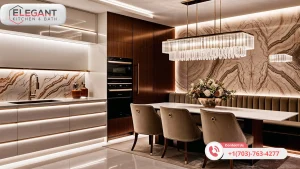
Maintaining and Caring for Luxury Lighting Fixtures
Maintaining and caring for luxury lighting fixtures is essential to ensure their longevity and continued elegance in the kitchen. This includes employing cleaning techniques suited to different fixture types, replacing bulbs with long-lasting alternatives, and scheduling regular maintenance checks. Each of these practices contributes to preserving the aesthetic appeal and functionality of the kitchen’s lighting design.
Cleaning Techniques for Different Fixture Types
Cleaning techniques for different fixture types are crucial for maintaining the elegance of luxury lighting in a kitchen. For glass fixtures, homeowners should use a soft, lint-free cloth and a mild glass cleaner to avoid scratches while ensuring a streak-free shine. Regular cleaning not only enhances visibility but also showcases the beautiful design elements that complement cabinetry and overall kitchen aesthetics.
For metal fixtures, such as bronze or nickel, a damp cloth with a gentle cleaning solution is recommended to remove dirt and fingerprints without damaging the finish. Homeowners should avoid abrasive cleaners that can dull the surface. Establishing a routine for cleaning these fixtures helps retain their original beauty, contributing to the kitchen’s stylish atmosphere.
Replacing Bulbs With Long-Lasting Alternatives
Homeowners should consider replacing traditional incandescent bulbs with energy-efficient LED alternatives to enhance their kitchen’s lighting design. LED bulbs offer a longer lifespan, reducing the frequency and cost of replacements, while providing ample brightness that improves overall functionality. By choosing these efficient options, users can create a well-illuminated environment that complements elegant fixtures without compromising on style.
In addition to longevity, LED bulbs come in various color temperatures, allowing homeowners to select lighting that aligns with their kitchen’s ambiance. This adaptability ensures that the light enhances cabinetry and design elements effectively. By integrating long-lasting LED solutions, individuals can maintain the beauty and functionality of their luxury lighting fixtures, contributing to a more inviting and sophisticated kitchen space.
Scheduling Regular Maintenance Checks
Scheduling regular maintenance checks for luxury lighting fixtures is essential in preserving their sophistication and functionality. Homeowners should create a maintenance calendar that includes periodic inspections to assess the condition of bulbs, wiring, and fixture integrity. By staying proactive with maintenance, individuals can ensure that elegant lighting designs remain in optimal condition and continue to illuminate their kitchens effectively.
During these maintenance checks, attention should be paid to the cleanliness of the fixtures and the bulbs used. Cleaning and replacing bulbs, particularly in high-use areas, significantly extend the life of the lighting and enhance the esthetic appeal of the kitchen. A well-maintained lighting system reinforces the overall elegance of the design:
- Inspect bulbs for signs of wear or burn-out.
- Clean fixtures to remove dust and smudges.
- Check wiring for any damage or fraying.
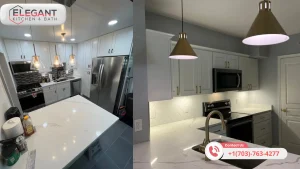
Elegant Kitchen Lighting FAQs for Franklin Farm, Virginia Homeowners
What are the three purposes of lighting?
The three main purposes of kitchen lighting are ambient, task, and accent lighting. Ambient lighting provides overall illumination, task lighting focuses on specific work areas, and accent lighting highlights decorative features. Combining these creates a well-balanced, functional, and aesthetically pleasing kitchen environment.
What lighting is fashionable?
Fashionable kitchen lighting trends for 2024 include curved silhouettes, layered lighting, and sculptural statement pieces. Pendant lights with clean lines and traditional designs are popular. LED strip lights for under-cabinet lighting are also trendy. Brass tones, cement fixtures, and carved-out shapes are stylish choices for statement lighting.
How many types of light should a good lighting design include?
A good kitchen lighting design should include three types of light: ambient, task, and accent lighting. Ambient lighting provides overall illumination, task lighting focuses on work areas, and accent lighting highlights specific features. This layered approach ensures functionality, safety, and aesthetic appeal in your kitchen space.
What is the functionality of lighting?
The functionality of kitchen lighting is to provide adequate illumination for various tasks, enhance safety, and create a welcoming atmosphere. Proper lighting allows for easy food preparation, cooking, and cleaning. It also helps prevent accidents by illuminating potential hazards and contributes to the overall ambiance of the kitchen.
What are the 5 functions of lighting?
The five main functions of kitchen lighting are:
- Providing general illumination (ambient lighting)
- Facilitating specific tasks (task lighting)
- Highlighting decorative elements (accent lighting)
- Enhancing safety and preventing accidents
- Creating atmosphere and setting the mood
These functions work together to create a well-lit, functional, and inviting kitchen space.
How can I create a layered lighting effect in my kitchen?
To create a layered lighting effect, combine ambient, task, and accent lighting. Use ceiling lights or recessed fixtures for overall illumination, under-cabinet lights for task areas, and pendant lights over islands. Add accent lighting to highlight architectural features or decorative elements. This approach ensures a well-lit, functional, and visually appealing kitchen space.
What are the benefits of using pendant lights in a kitchen?
Pendant lights offer numerous benefits in kitchens. They provide focused task lighting, enhance visual interest, and serve as stylish design elements. Pendant lights are versatile, available in various styles to complement any décor. They also offer adjustable heights for optimal illumination and can combine ambient and task lighting functions. Many modern LED pendants are energy-efficient, reducing power consumption.
How does ambient lighting impact the overall ambiance of a kitchen?
Ambient lighting sets the mood and provides overall illumination in the kitchen. It creates a welcoming atmosphere and ensures even light distribution throughout the space. Proper ambient lighting can make the kitchen feel more spacious and inviting. By using dimmable fixtures, you can adjust the brightness to suit different activities and times of day, enhancing the kitchen’s versatility.
What are some popular trends in kitchen lighting for 2024?
Popular kitchen lighting trends for 2024 include curved silhouettes, layered lighting designs, and sculptural statement pieces. Natural materials and mixed finishes are gaining popularity. Pendant lights with clean lines and traditional designs are trending. LED strip lights for under-cabinet lighting continue to be fashionable. Cozy lamps and over-island lantern pendants are also emerging as stylish choices.
How can I incorporate accent lighting to highlight my kitchen’s architectural features?
To highlight architectural features, use accent lighting strategically. Install LED strip lights or spotlights to draw attention to exposed beams, archways, or alcoves. Use picture lights or LED strips to illuminate open shelving or artwork. Consider decorative wall sconces to create focal points. Accent lighting can also be used to highlight a statement island or unique backsplash, adding depth and visual interest to your kitchen design.
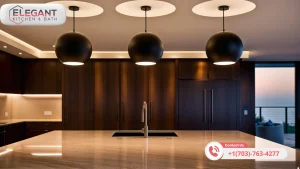
Conclusion
Transforming a kitchen with elegant lighting designs significantly enhances both its functionality and aesthetic appeal. Key considerations include balancing natural and artificial light, selecting fixtures that complement cabinetry, and strategically illuminating essential areas. By incorporating elements such as statement chandeliers, pendant lights, and under-cabinet options, homeowners can create inviting spaces that elevate everyday experiences. Ultimately, thoughtful lighting choices not only provide practical benefits but also contribute to the overall elegance and warmth of the elegant rich kitchen.
Elegant Kitchen and Bath offers kitchen remodeling, bathroom remodeling, basement remodeling and home addition remodeling services across a broad area, including;
Herndon, Chantilly, Centreville,Reston, Sterling, GreatFalls, Ashburn, Fairfax, McLean, Manassas, Haymarket, Burke,
Vienna, Falls Church, Annandale, Springfield, Alexandria and Arlington.
Ready to transform your bath with Elegant Kitchen and Bath in Virginia?
Visit Elegant Kitchen and Bath not My Kitchen and Bath to start your journey toward your modern kitchen & bath today.

